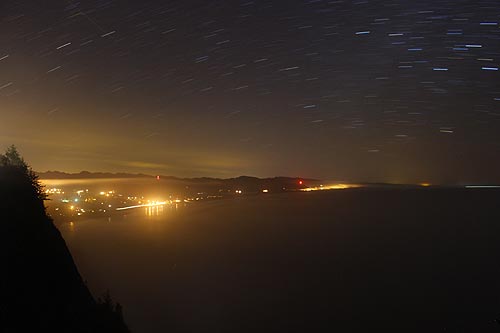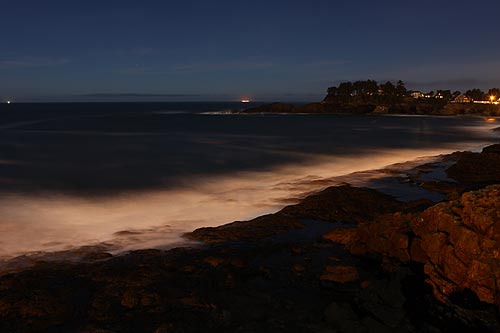 |
Stargazing and Night Photo Tips on the Oregon Coast, Part 2
Published 03/02/2011

(Oregon Coast) – In part one of this series, we talked about tips for stargazing along the Oregon coast, and how, when and where to best take advantage of the exception clear conditions that can allow for amazing views above the nighttime beaches (above: the overlooks above Manzanita in the middle of the night).
Now, thanks to Jim Todd at Portland’s OMSI, it's time to take a look at the further freaky discoveries you can make playing with star trail photographs yourself.
All these photographs in this article, and in its companion articles (including the Compendium of Astronomy Shots”) were done using long exposure of several minutes or more – except the moon photos. Interestingly enough, the moon is so bright you can capture it with a high shutter speed and holding the camera by hand.

Star trails are the natural result of shooting long exposures at night – which you need to do to actually catch a night sky in your camera. It has to sit on a tripod, and depending on your film speed, you’ll have to shoot anywhere from 15 seconds to 10 minutes to get anything to register.
Once you leave a shutter open for longer than 15 seconds, the Earth’s movement causes a star to move, creating star trails. The longer it’s open, the longer the trail of the point of light. In many cases, these shots here were taken with at least three minute-long exposure, while many five to ten minutes.

One of the first things you’ll notice is a strange shift in colors among some of the star trails. Some are blue, some are whitish, some are orange and so on (photo above: the circular motion of the sky, looking straight up).
This is a combination of the fact a camera can see light wavelengths that a human cannot and what the atmosphere does.
“What most people don't understand about light is that the human eye doesn't discern between the chemical compounds that make up light,” Todd saiod. “Humans view a very narrow spectrum. Cameras, on the other hand, can pick up light wavelengths that is composed of chemical compounds like helium, hydrogen, and so on. These chemicals change the ‘color’ of light that that we can't easily see, but cameras can.”

Another interesting twist in photographing stars and their movement is the way they arc across the sky. Facing south, they move from horizon to horizon. Facing west, they appear to “rain” down on the Earth. Other directions show a different pattern and direction (above: night sky above Newport).
This may be a bit confusing to some at first, but the explanation is quite simple. It’s because of the way the Earth is moving, causing the stars to move in a different way. Since the Earth is spinning on its north to south axis, you’ll see the stars curve overhead accordingly. But if you’re looking west or east, you’re seeing them curve a different direction.

For those looking to experiment with their own star trail shots, Todd has further advice (above: a little bit of star trail over Cannon Beach).
“The stars’ apparent movement is largely dependent on your lens,” he said. “The longer the focal length, the more apparent the movement; the wider angle lenses won't show much movement till later because of the star point is so small. For comparison, a close-up photo of the moon can only be about six seconds before the Earth's movement blurs it. Part of your experimentation will be to gauge the timing for how much ‘trail you want.”

Depoe Bay at night
More About Oregon Coast hotels, lodging.....
More About Oregon Coast Restaurants, Dining.....
 |
 |
LATEST OREGON COAST NEWS STORIES
Whale Body Parts Found on Oregon Coast - Two Whales Strand on Washington Coast |
Secrets of the Season |
Unusual Travel Articles TravelParanormal.com allows you to submit your own creepy tale or debunk one - or see up-to-the-minute news headlines about travel and the paranormal. News Headlines from All Over Oregon Need to scan Oregon headlines? Constantly updated news from all over Oregon: a comprehensive, up-to-the-minute display of news headlines from a variety of media |
Back to Oregon Coast
Contact Advertise on BeachConnection.net







































